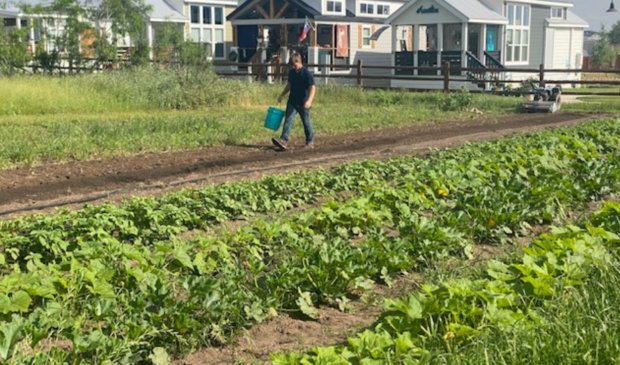City could push ‘agrihood’ combos of farmland, housing developments in East Austin
Wednesday, April 24, 2024 by
Chad Swiatecki The city may soon take steps to promote the creation of “agrihood” developments in Northeast Austin, which would combine small community farms with housing. Proponents of the movement see the still-rare projects as an answer to Austin’s housing needs and development pressures as well as a way to bring more stability to the local food system.
Tuesday’s meeting of City Council’s Housing and Planning Committee included an extended discussion on the benefits and feasibility of agrihood planned communities. The discussion ended with passage of a recommendation that City Council direct staff to study what planning and financial considerations and community partnerships would be necessary to help hopeful farmers in the area cooperate with developers on creating more agrihoods in the recently established Northeast Planning District.
Currently, Green Gate Farms near the Travis County Expo Center is the sole agrihood in the area, and is seen as one of the more unique developments in the country. Co-owner Erin Flynn shared with the committee the path she and her husband took to establish the farm almost 20 years ago. They partnered with a developer who purchased the property to preserve some of the farmland to offer it as a community amenity to the new homes built nearby.
“Not only does our agrihood community prove that this concept works, it shows that agrihoods are ready for prime time. It’s time that agrihoods are made available to everyone,” she said. “It’s time for city-supported agrihoods. Our agrihood demonstrates that well-designed, farm-centered communities can offer affordable housing. They can increase food security, preserve farmland, improve health and well-being, create new careers for farmers and provide essential services during climate emergencies.”
Proponents of the agrihood movement argue that it ties in well with the city’s soon-to-be-final five-year food plan and 2022 report, which found that development is removing almost 17 acres of farmland per day, most of which is located in the Eastern Crescent region that is known for its productive soil as well as its more affordable land prices.
The meeting also featured stakeholders from a successful agrihood in Santa Clara County, California, who offered some guidance on the financial requirements and planning steps needed to intermix farming with a variety of housing types at affordable and market-rate price levels.
Council Member Natasha Harper-Madison, whose district includes the areas identified as most desirable for agrihoods, said the city needs to find ways to expedite any zoning or planning steps needed to design and start small farms mixed with housing developments.
“Austin has one, Houston has a couple, Central Texas has a handful, just thinking through what things are best practices nationally, but then coming back down and getting a little more granular and figuring out what’s best practices for us,” she said. “In a lot of ways, what we’re trying to figure out is a model that we can duplicate. Look at national best practices to get a general idea of what the template looks like and then go from there into making it uniquely suit our unique region.”
Michelle Akindiya, education director at Farmshare Austin, said only a quarter of the more than 100 graduates of the organization’s Farmer Starter program say they have access to the land needed to start a small farm that could serve the Austin region almost exclusively.
“One of the things that we’re trying to do is determine how do we continue to support these new farmers so that they can actually create a long-term career in agriculture. The role in agriculture that the agrihood could play in that could be really instrumental,” she said. “There’s this beautiful way where it can connect affordable housing, can connect that food access and food security piece with the farmer training and farmland preservation piece. It can be this multifunctional support system to tie these really essential pieces of our day-to-day lives together.”
The Austin Monitor’s work is made possible by donations from the community. Though our reporting covers donors from time to time, we are careful to keep business and editorial efforts separate while maintaining transparency. A complete list of donors is available here, and our code of ethics is explained here. This story has been changed since publication to reflect the fact that the five-year food plan is still a draft.
You're a community leader
And we’re honored you look to us for serious, in-depth news. You know a strong community needs local and dedicated watchdog reporting. We’re here for you and that won’t change. Now will you take the powerful next step and support our nonprofit news organization?







